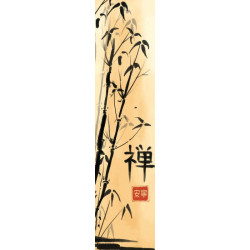












Asian-inspired graphic with calligraphy brush strokes, bringing you a lovely Zen display.
Photo privacy screen with decorative function
Easy to Install and Remove: Our Privacy Screens can be easily installed on a fence, wall, or balcony using flexible fasteners
Storage: The flexible material allows the Privacy Screen to be reused as many times as desired for any season and event
Outdoor Resistance: Great or strong weather conditions such as UV rays, wind, and low temperatures
HD Print Quality: Our Privacy Screens are produced using the latest HD Latex technology or UV Digital Printers with certified environmentally friendly ink. Optional fire rating is available upon request
Our Privacy Screen materials are tear-proof and designed for outdoor use. Ideal in strong weather conditions such as rain, strong sun exposure and low temperatures.
Privacy Screens can be installed using fasteners or hooks. Avoid setting up in strong, windy conditions. Follow the instructions provided for easy installation. Fasteners, hooks, dowels, and screws are not included with purchase.
The grommets installed in our Privacy Screens can be attached to a balcony, fence, or any barrier with flexible fasteners. Installed with hooks against a wall.
The Privacy Screen can be installed using the hooks at the top and bottom corners of the fabric. Mark your areas with a pencil and drill the holes according to the surface material. Position the top and bottom hooks, passing them through the slots provided for this purpose, taking care to obtain good tension.